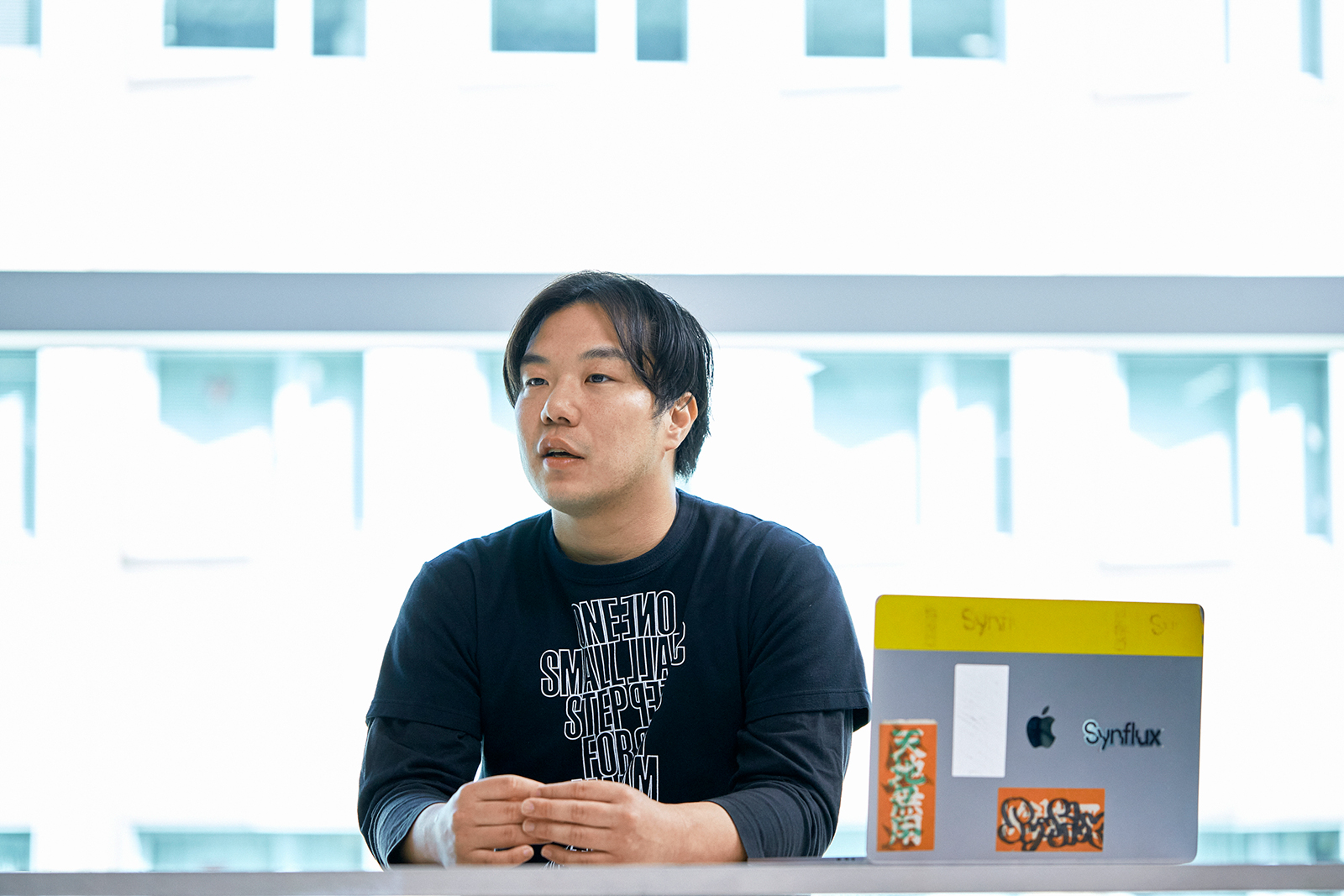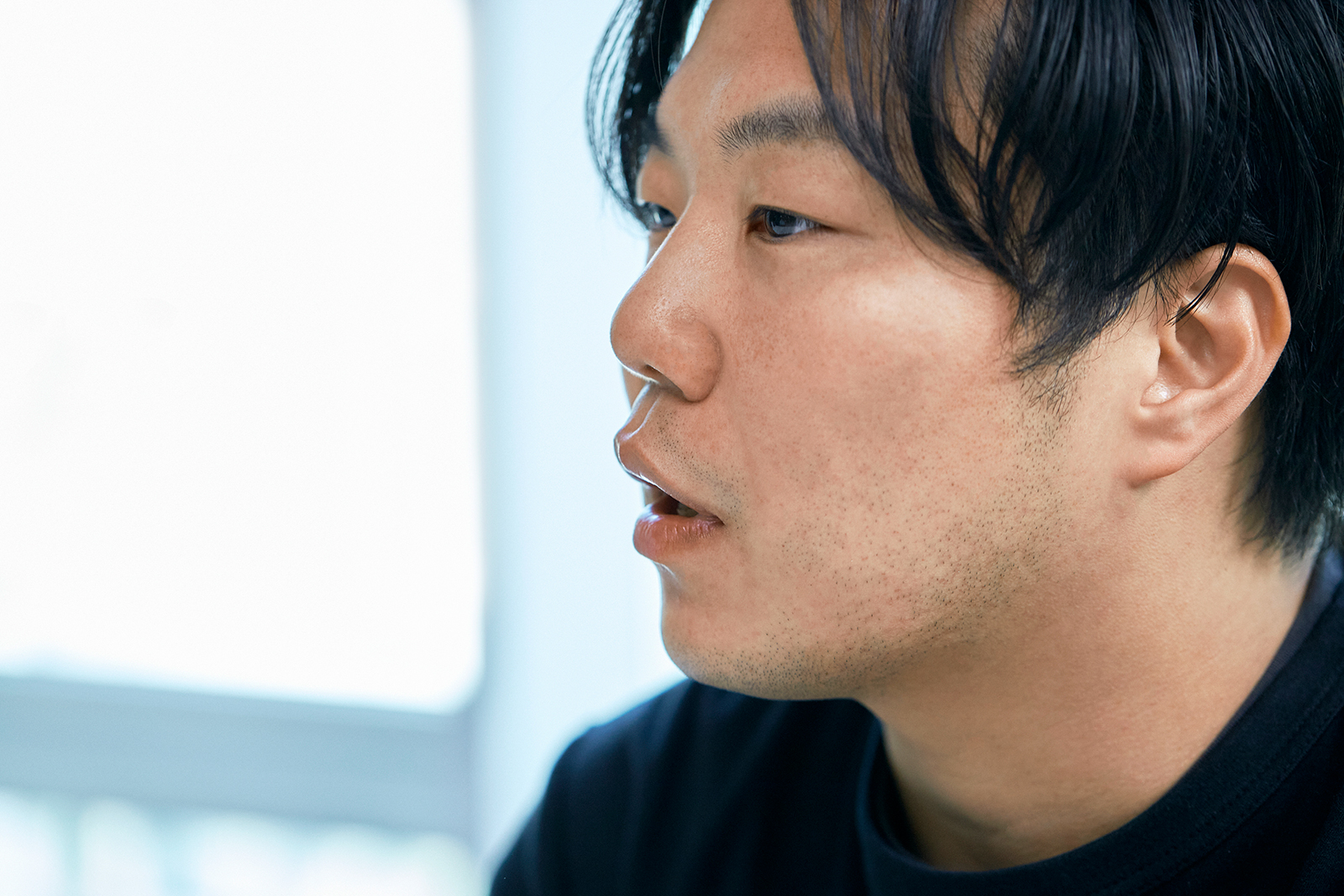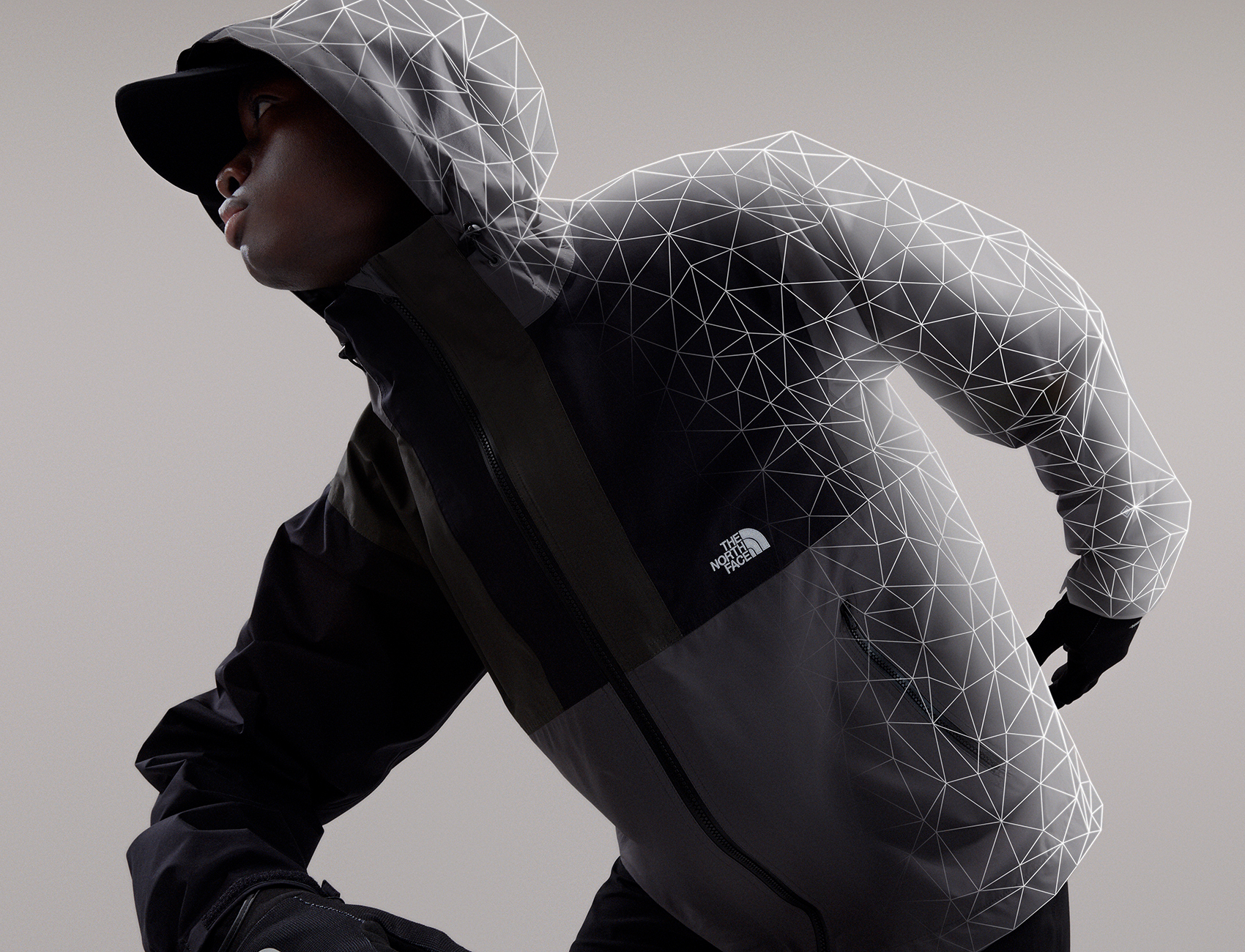
Goldwin Play Earth Fund PORTFOLIO INTRODUCTION
Vol.2Synflux Co., Ltd.
Synflux, a company funded by the Goldwin Play Earth Fund, aims to conduct innovation in the fashion industry, which is entrenched in outdated paradigms, and reduce its environmental impact by harnessing digital technology. What is “Algorithmic Couture,” its principal service and a system that has won world-class awards? And how can fashion contribute to address environmental issues?
We visited Kazuya Kawasaki, CEO of Synflux, to get the answers.
A solution to environmental problems – from fashion
Please introduce Synflux.

Kazuya Kawasaki:Synflux is a design startup with “FASHION FOR THE PLANET” as its mission. In this time of environmental crisis, we are developing and applying digital technology – our forte – to create new clothing designs optimized to tackle complex environmental problems.
A key service is “Algorithmic Couture,” right?
Kazuya Kawasaki:Algorithmic Couture is a system that combines artificial intelligence with 3D mapping to minimize waste in the apparel manufacturing process. More specifically, it offers two functions: Proposing designs that bear absolutely minimal waste, and automatically generating and optimizing patterns.
When we input 3D renderings of clothing into our system, it traces the contours of the item and converts the data into a 2D matrix calculated to avoid waste – imagine peeling an orange and projecting a flat grid of the peel onto paper. Also, from the 3D data, the system automatically outputs generic pattern data that is ready for transposing onto the fabric to be cut.
I see. So AI draws outlines for patterns that have traditionally been drawn by humans... Will we eventually get to the point where a computer designs clothes?
Kazuya Kawasaki:Our stance is more about supporting the work of designers and pattern makers. Pattern-making has acquired knowledge from its long history, so the intervention of human hands continues to be indispensable. We’d like to try using computers to create designs from scratch, but the first priority is to support pattern makers and designers in order to reduce the amount of waste.
In the first place, where does your environmental awareness come from?
Kazuya Kawasaki:I'm from a rural part of Niigata Prefecture, and before I moved to Tokyo, I never imagined that I’d be involved in fashion or design. To be honest, I was someone who came to Tokyo without thinking about anything (laughs), just to attend a university. It was 2011, the year of the Great East Japan Earthquake, so there was no entrance ceremony and all kinds of activities were suspended.
During that time, I had the opportunity to go to a disaster-struck area and I was shocked to see how easily food, clothing, and shelter could be destroyed through forces unleashed by nature. I felt that we must think about how to restructure and maintain the ways to feed, clothe, and house humanity, taking natural threats into account.
So the earthquake changed the way you think about your daily life?

Kazuya Kawasaki:I quit the university I was attending and switched to another to study fashion design. Sustainability was already being discussed within the apparel industry at the time, and we were gradually shifting away from the conventional idea of clothing as consumables to sell, buy, and throw away. I thought about what kind of new fashion and design I could propose, and I teamed up with friends who were strong in digital technology at my university and graduate school, and together we started a company.
The environment is an issue no industry can ignore, so why did you choose fashion?
Kazuya Kawasaki:I was strongly attracted to the creativity of fashion. It covers a wide spectrum of subjects, from matters related to human desires that some consider superficial, such as “coolness” or “beauty,” to functionality that makes our daily lives more comfortable. When we take on environmental issues, I believe a deeper insight into human society can reveal approaches to the problem in a way that is more interesting, cool, and beautiful.
While scrupulous, steady approaches to environmental issues are certainly valuable, there are many different possibilities, aren’t there?
Kazuya Kawasaki:The creativity of fashion and the ideas of fashion designers are becoming more pertinent in addressing the environmental crisis. And because fashion is strongly related to human desires and consumerism, it gives us keys to seeing the issue from a completely new perspective.
In addition to taking conventional approaches to the crisis, I think it’s critical to look at fashion from the perspectives of human desires, consumerism, and society: When do people find a product intriguing? Why can’t they help buying it? How should we communicate with them to make them interested?
Digitalization – challenges and future
Tell us about your plans for the future of Synflux.
Kazuya Kawasaki:As Algorithmic Couture is the core technology of our operations, one thing we want to concentrate on is the comprehensive digitalization of fashion design. Synflux’s strength lies in working with digital data of the body and clothing. Currently, to reduce the environmental impact of fashion, we are focused on creating a system that cuts fabric waste down to zero. The same data on clothing and bodies can be utilized to create patterns that fulfill other objectives, for example, improved functionality.
And since body and clothing data are required to create avatars for virtual spaces, I wonder if our technology can be applied to designs in the metaverse as well.
What are the benefits of going digital?
Kazuya Kawasaki:An advantage of digital is that it outputs quantifiable information. So, for example, if we reduce waste, we can track and make transparent the degree of reduction and identify the factors that contributed. These days, it's called “traceability.” With the next era in mind, we need to coordinate design processes with complex environments, including those of information and nature. I want to advance the comprehensive digitalization of fashion design as our business for such an era.
What are the hurdles for a service like Algorithmic Couture to be implemented across the fashion industry?
Kazuya Kawasaki:It’s said that the core methodology of fashion design has remained largely unchanged since its establishment in France some 200 years ago. In Japan, the culture of Western clothing was introduced during the Meiji period (1868–1912), and although production methods have been updated, basic practices have stayed the same to this day. Because of the weight of this long history, I feel every day that reforming fashion design will take a lot of time and require a drastic change of perspectives.
We’d love to collaborate on digitalization with people from a wide variety of industries. We’re ready to actively discuss with those who value craftsmanship and hand-made products. If that’s going to take time, we are prepared to take that time and talk to them with respect and sincerity. It’s a challenge we will take up.
Cost reduction by digitalization would be a persuasive case to be adopted, wouldn’t it?

Kazuya Kawasaki:Simply put, producing trash is literally “a waste.” If the amount of fabric used is optimized and the amount of fabric wasted is minimized, not only environmental costs but also economic costs can be reduced. Many new solutions to the environmental crisis are emerging, but they are often costly to develop and implement. I personally believe we should nevertheless be proactive in using them, but if that results in only those who can afford high prices buying eco-friendly products, it is putting the cart before the horse.
Once a startup company develops a product, reducing the cost of production becomes its mission at some point. We would be happy if people paid attention to the fact that our technology can help reduce both environmental and financial costs.
Practically speaking, I imagine that the larger the manufacturer you collaborate with, the larger the ripple effect on environmental protection will be. Your thoughts?
Kazuya Kawasaki:In this time of environmental vulnerability, you can’t deny that manufacturing large quantities of products entails a great deal of responsibility. Based on that fact, we want to maximize our beneficial effects on the environment and economy by collaborating with partners who share our sense of duty to the present and future. We hope to share our awareness of the environmental crisis and our vision with as many people as possible, but we are only halfway there. Lately, I’ve been thinking that forming an alliance could be key.
Alliance?
Kazuya Kawasaki:Naturally, brands and companies focus on their own profits. Of course, that’s required for any company’s survival. But I think the plight of the global environment can give birth to a common vision that leads to an alliance of some kind.Synflux wants to help build such an alliance, one that brings people together to think about using digital technology in monozukuri [the art of making things] to address the environmental crisis.
Never stop exploring, even if the goal seems unreachable
The Goldwin Play Earth Fund decided to invest in Synflux at the end of 2022. How did that come about?
Kazuya Kawasaki: It began two years previously when I appeared on stage at an event with Gakuto Otsubo , head of NEUTRALWORKS., one of a Goldwin’s original brand . When I talked about what we were doing at Synflux, he said, “That’s very interesting.” With that interaction, we started SYN-GRID, a joint project with brands from Goldwin. Now, following a year and a half of development, we have finally launched products.
A fruition of SYN-GRID has been the release of respective products by THE NORTH FACE and NEUTRALWORKS.


Kazuya Kawasaki:Both products significantly reduce fabric waste. THE NORTH FACE jacket is based on the design of an already popular item, while NEUTRALWORKS. takes advantage of its status as a new brand to offer a matching fleece top and bottom, employing a bold design.
So the SYN-GRID project had already started before you received the investment.
Kazuya Kawasaki:The period leading up to the launch of SYN-GRID, I think, was not only to work with GOLDWIN on product development but also to share ideas – such as a vision for sustainability – at a conceptual level. It was during this time that Mr. Otsubo introduced the Goldwin Play Earth Fund to us, and that led, after many discussions, to getting the investment.
How do you perceive the Goldwin Play Earth Fund?
Kazuya Kawasaki:The other day, I heard a presentation by Goldwin President Takao Watanabe, and what he emphasized was the importance of circularity. Synflux also believes strongly that the concept of circulation will become increasingly consequential to fashion and design, so this resonated with me very much.

I understand that the phrase “Play Earth” also represents this idea – that play as a part of thinking and creating can lead to contributing to the Earth’s well-being. This is especially suited to the fields of outdoor activities, sports, and fashion, and this is another area where we are in sync with the Goldwin Play Earth Fund. Another thing is “Never Stop Exploring,” THE NORTH FACE’s well-known tagline; I think this in fact is what we call “venture spirit.” When you think deeply about environmental issues, you may be daunted by their complexity and want to give up, but you keep on going, exploring how to solve them while having fun. When I unpacked the meaning of this tagline, I felt it reaffirmed our collaboration.
What kinds of activities do you intend to initiate together with the Goldwin Play Earth Fund?
Kazuya Kawasaki:We understand that the investment was based on Synflux's approach to the environmental crisis and our track record. We are still just one startup, but with the support of the Goldwin Play Earth Fund, we hope to create future circular fashion that thrives significantly.
PROFILE
Kazuya Kawasaki (Synflux Co., Ltd. CEO)
Born in Niigata Prefecture in 1991. Upon receiving a master's degree in design from the Graduate School of Media and Governance at Keio University, and winning the H&M Foundation Global Change Special Award, Kawasaki co-founded Synflux with current CDO Kotaro Sano. He is also the author of several books, including Sustainable Fashion (Gakugei Shuppansha, 2022).
Photo_Shohei Kabe
Movie_Kohei Yamaji
Text_Shinri Kobayashi
Edit_Hideki Shibayama(HOUYHNHNM)

